 W
WBad Nieuweschans is a village with a population 1,510, located in the north-eastern Netherlands on the border with Germany. It forms part of the municipality of Oldambt. Nieuweschans means "new fortification (sconce)". In 2009, the word Bad ("spa") was prefixed to the name of the village to promote it as a tourist destination.
 W
WFort Bourtange is a fort in the village of Bourtange, Groningen, Netherlands. It was built under orders of William the Silent and completed in 1593. Its original purpose was to control the only road between Germany and the city of Groningen, which was controlled by the Spaniards during the time of the Eighty Years' War.
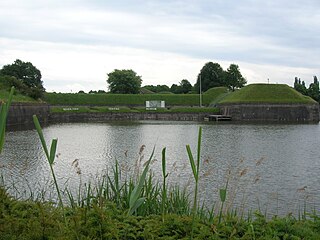 W
WThe Dutch Fortress Museum is located in the city of Naarden, The Netherlands. The Museum was established by volunteers in 1955 at bastion Turfpoort, one of six bastions that give the walled city its distinctive star shape. The fortifications themselves, including the bastions, date from the period 1575-1585, when King Philip II of Spain ordered them to be constructed.
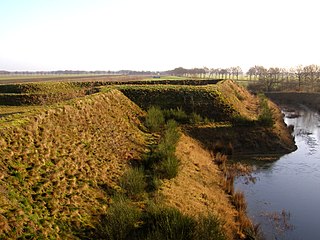 W
WThe building of the Friese Waterlinie started around 1580. The traject of the defenceline starts at the Zuidersea, along the river Linde until the De Blessebridge. Then the defence line goes to the north to Kuinre along Heerenveen, Terband, Gorredijk, Donkerbroek, Bakkeveen until Frieschepalen.
 W
WThe Fort along Den Ham is a fort that is part of the UNESCO World Heritage site of the Stelling van Amsterdam. It's located along the railroad from Uitgeest to Krommenie. The earthen walls date from 1896, the fort itself was finished in 1903.
 W
WThe Fort bij De Kwakel is a fort that is part of the Stelling van Amsterdam. It's located in the village of De Kwakel. It's one of four forts that form the linie Kudelstaart - Uithoorn. To the west is fort bij Kudelstaart, to the east you find fort aan de Drecht and fort bij Uithoorn.
 W
WLammenschans refers to a former fort located in Leiden along the Vliet. Today the Leiden Lammenschans railway station is located there. According to local legend, a large Spanish cooking pot filled with hutspot was found there on 3 Oktober 1574 by Cornelis Joppenszoon after the Spanish forces fled at the conclusion of the Siege of Leiden. Later historians have concluded that this pot, which today is in the collection of the Museum De Lakenhal, was actually found by Gijsbert Cornelisz. Schaeck and was engraved with the story by his son in the 17th century. A statue of Cornelis Joppensz with his pot can be seen at the train station today. The Leiden rescue, or Leidens Ontzet is celebrated each year in Leiden on October 3rd.
 W
WMouse Fort is a Dutch fort in Muiden. The fort is part of the Stelling van Amsterdam, the UNESCO World Heritage site that consists of a set of forts around the city of Amsterdam.
 W
WOudeschans is a small village with a population of around 100 in the municipality of Westerwolde in the province of Groningen in the Netherlands. The 16th-century fortification is now a state protected village area with several national heritage sites, among which a 17th-century garrison church, and the Vestingmuseum Oudeschans.
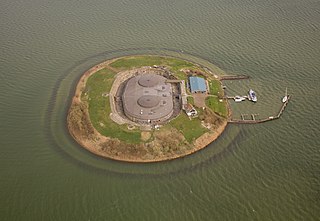 W
WPampus is an artificial island and late 19th-century sea fort located in the IJmeer near Amsterdam. Pampus now belongs to the municipality of Gooise Meren and is open to visitors.
 W
WFort De Roovere is an earthen fort, constructed as part of the Dutch Water Line,, a series of water-based defences conceived by Maurice of Nassau in 1628 during the Eighty Years War where it defended against Spanish attackers. It is located near Halsteren.
 W
WThe UNESCO World Heritage Site known as the Defence Line of Amsterdam is a 135 km ring of fortifications around Amsterdam. It has of 42 forts that are 10–15 km from the centre and lowlands, which can easily be flooded in time of war. The flooding was designed to give a depth of about 30 cm, too little for boats to cross. Any buildings within 1 km of the line had to be made of wood so that they could be burnt and the obstruction removed.
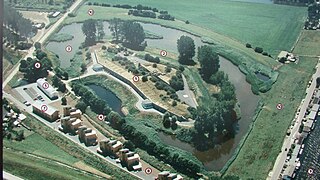 W
WFort Vijfhuizen is one of forty-two forts in the Defense Line of Amsterdam, a World Heritage Site. It is located in the town of Vijfhuizen on the ringvaart which surrounds the Haarlemmermeer polder. The main fort is currently maintained by a charitable foundation called Kunstfort Vijfhuizen which leases space for twelve artist studios and a restaurant.
 W
WVuurtoreneiland is a small island in the IJmeer, Netherlands, just off the coast of Durgerdam. The island's main function is as a base for a lighthouse; a military fort on the island was abandoned in the 1930s.
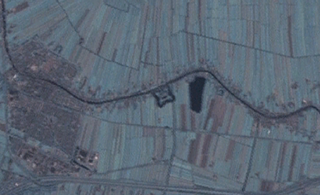 W
WThe Wierickerschans Fort is a part of the Old Dutch Waterline or "Oude Hollandse Waterlinie". This was a defence system that allowed large parts of the country (Holland) to be flooded (inundated). Thus protecting the main towns and city in the West against invading forces from the East. It was in use right up to the 19th century. The Fort was built on the site where in 1672 Stadtholder Willem III had his headquarters during the war against the French. The Fort is centrally located within the Old Dutch Waterline that stretched from Muiden down to the Biesbosch.